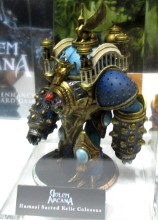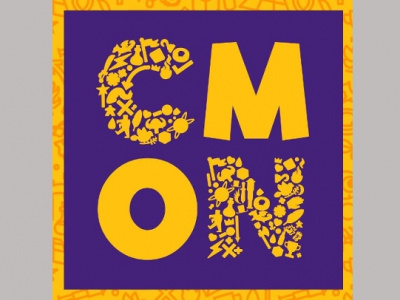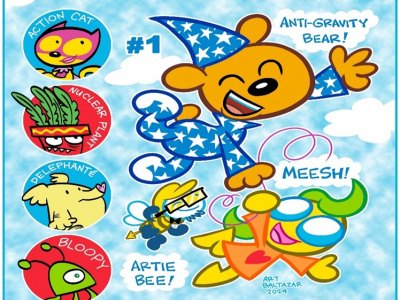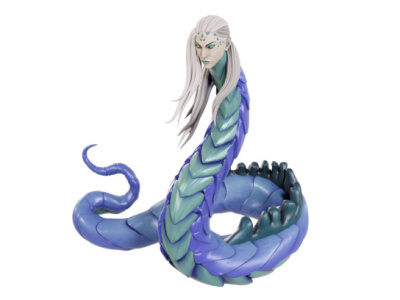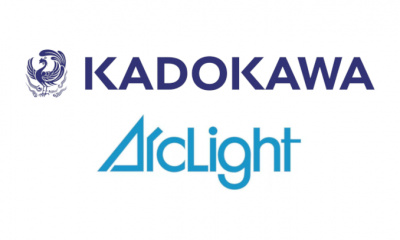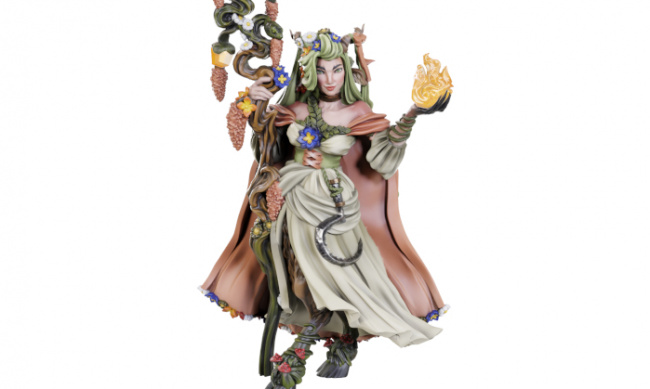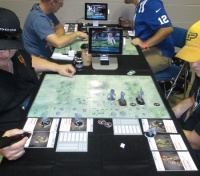 Harebrained Schemes co-founder and legendary game designer Jordan Weisman (Shadowrun, BattleTech, MechWarrior, Mage Knight, HeroClix) has designed a new game that bridges the physical and digital worlds. Golem Arcana is played on terrain with miniatures aided by a tablet or smartphone. We spoke to Weisman, co-founder of Harebrained Schemes, at Gen Con (occasionally aided by Harebrained producer and metrics analyst Brian Poel). In Part 2, Weisman gives more game details and talks about what retailers can expect. In Part 3, we talked about the Kickstarter, the product configuration, and the company behind it. In Part 1, Weisman talked about the game play and the technology.
Harebrained Schemes co-founder and legendary game designer Jordan Weisman (Shadowrun, BattleTech, MechWarrior, Mage Knight, HeroClix) has designed a new game that bridges the physical and digital worlds. Golem Arcana is played on terrain with miniatures aided by a tablet or smartphone. We spoke to Weisman, co-founder of Harebrained Schemes, at Gen Con (occasionally aided by Harebrained producer and metrics analyst Brian Poel). In Part 2, Weisman gives more game details and talks about what retailers can expect. In Part 3, we talked about the Kickstarter, the product configuration, and the company behind it. In Part 1, Weisman talked about the game play and the technology.How long does a game take?
Weisman: A typical, what we’re calling 'tournament scale' game, where you have somewhere in the neighborhood of five to eight figures against another person, is going to be roughly 45 minutes. Of course, players can make the game as big as they want, and can take all day. If they want to play with 50 figures, the game can handle that. Especially if you start using big guys like the Colossus, those are huge figures.
One of the cool things about the Colossus, you can also assign that figure to be an A.I. character. So then the game system will run that character, so you can play at home by yourself. You can take a small army up against the Colossus, with the A.I. managing the Colossus.
Is that only true of the Colossus figures? The A.I.?
Weisman: In the Kickstarter there are going to be two stretch goals associated with A.I. The first is the Colossus. Then a later stretch goal is full army A.I., so I can have a full army, and play a full army. The reason that is a bigger deal is that the game has so much combinational game play, the A.I. has to be really smart to figure out how to use those combinations intelligently. So it’s a big project to do the A.I. It’s certainly doable, but we just had to put it higher on the stretch goals.
What’s the universe?
Weisman: The universe of Golem Arcana is one of high magic. There is a race called the Ancient Ones which built these giant golems, and literally sculpted the surface of the planet. They consumed so much mana that they’ve now ascended, and their bloodlines, their descendants, are the people that you play. If you are a character that is a bloodline descendant, then that’s how you call in their blessings and curses to aid you on the battlefield. As you’ve seen in my other games, there’s a lot of political depth, a lot of world building.
This one is based a lot on Babylonian Sanskrit mythology and then mixing it with a lot of cool stuff out of the life and times of Genghis Khan. So there is a lot of fun stuff. Some of the fiction is already coming out on our website and we really want to push it a lot deeper. There are a lot of really cool factions and fiction for it. Some people have said it reminds them of a fantasy version of BattleTech, which is kind of true--it is giant creatures that you’re piloting into battle, but since I designed BattleTech 30 years ago, I’ve learned a lot in between, and we’re trying to apply that here.
For instance, what is always frustrating in BattleTech, and a lot of miniature games, is that after you lose the first figure or two, it’s pretty hard to turn it around. Usually, the guy who gets first blood wins. So in this game, one of the concepts is that you have this idea of mana. As you move around the board, you gain mana, you give that to your Ancient Ones, and get blessings and curses back. When you lose a figure, you get a lot of mana, you get a big mana bonus based on the point cost of the figure. So I may have lost a figure but I gained a resource, which I can then use in blessings and curses so that I can help turn that around. So those are the computer game dynamics which we can now bring to the board.
What can retailers expect?
Weisman: One of the things we really want to make retailers aware of is that this is a product that is designed for retail, both on the figures ,the base game, map packs, all that stuff designed for retail and again, a lot of work on OP, so that we can get great communities going.
Poel: We can digitally convey new game scenarios to the players. Because the board has information about the tiles, we can send data down through the apps to say "in this scenario this tile has these properties, and that tile has these properties," so through organized play, without any additional purchases, a completely different user experience can be had.
Weisman: One of the things we really tried to design this for was to make sure it’s a great organized play system, and one that’s really smooth for a store. Because the rules are all adjudicated by the device, there aren’t any rules arguments. You don’t need to have a rules expert on your staff, because the game itself makes sure that the rules are followed. And because it’s all digital, all the data is automatically captured and moved up to our servers, so there is no data entry required by tournament organizers or anything like that.
As Brian said, new scenarios for organized play are automatically transmitted to the apps, so they’re available. You don’t have to worry about ordering something from the distributor and getting it in time. Similarly, participation benefits and prizes can be done digitally as well, so they don’t cost the retailer money or hassle to be able to do.
Some other cool things. Since every player is using an app, and all apps have a location, we can promote stores much easier than you ever could before. It can tell you, right when you boot up the App "Hey! There are tournaments being played at these stores within 20 miles of you!" We think that is going to be really great for community involvement, and to start that off, what we’re doing is, after the Kickstarter ends, every backer will be asked to name a retail store, to give us the name and address of a retail store they frequent. If we get five people from any one retail store, we will send that retail store a free starter set, with a whole bunch of stuff for them to be able to do demos because clearly they have people interested, let’s help them really grow that community by giving them the material to go out and demo it to a lot of other people.
But from a fictional standpoint, a scenario standpoint, the idea is that when you finish playing a game, the game generates a story of the game you just played, and then pushes that out to your social network, and then depending on how high you are rated in the area, depends on how far your story pushes out to the others. Because your story and scenario could have effect on the scenarios they’re going to play next week, and we want this to go all the way up to our level, where our authors are writing the Kings and Queens versions of the story which then goes down to the Generals, which are kind of the leader boards, they get scenarios, they play, and then the results of those scenarios drift down to the regional and your living room. And then what you did pushes back up. So you get this great kind of thing you could only do in computer games before but now we’re doing them on the tabletop.
Click here for Part 3.



